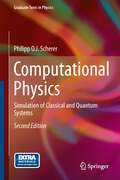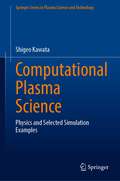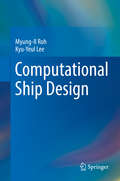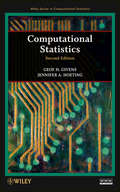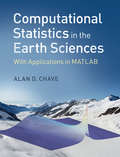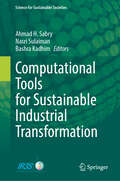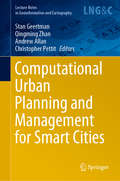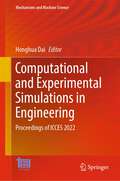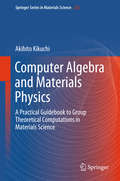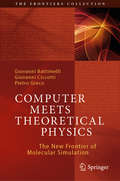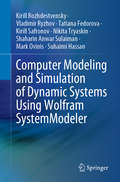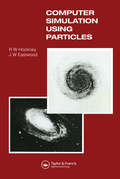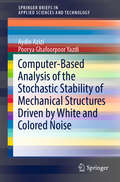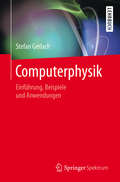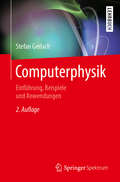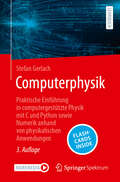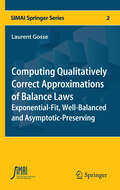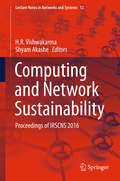- Table View
- List View
Computational Physics: Simulation of Classical and Quantum Systems (Graduate Texts in Physics)
by Philipp O. J. SchererThis textbook presents basic and advanced computational physics in a very didactic style. It contains very-well-presented and simple mathematical descriptions of many of the most important algorithms used in computational physics. Many clear mathematical descriptions of important techniques in computational physics are given. The first part of the book discusses the basic numerical methods. A large number of exercises and computer experiments allows to study the properties of these methods. The second part concentrates on simulation of classical and quantum systems. It uses a rather general concept for the equation of motion which can be applied to ordinary and partial differential equations. Several classes of integration methods are discussed including not only the standard Euler and Runge Kutta method but also multistep methods and the class of Verlet methods which is introduced by studying the motion in Liouville space. Besides the classical methods, inverse interpolation is discussed, together with the popular combined methods by Dekker and Brent and a not so well known improvement by Chandrupatla. A general chapter on the numerical treatment of differential equations provides methods of finite differences, finite volumes, finite elements and boundary elements together with spectral methods and weighted residual based methods. A comparison of several methods for quantum systems is performed, containing pseudo-spectral methods, finite differences methods, rational approximation to the time evolution operator, second order differencing and split operator methods. The book gives simple but non trivial examples from a broad range of physical topics trying to give the reader insight into the numerical treatment but also the simulated problems. Rotational motion is treated in much detail to describe the motion of rigid rotors which can be just a simple spinning top or a collection of molecules or planets. The behaviour of simple quantum systems is studied thoroughly. One focus is on a two level system in an external field. Solution of the Bloch equations allows the simulation of a quantum bit and to understand elementary principles from quantum optics. As an example of a thermodynamic system, the Lennard Jones liquid is simulated. The principles of molecular dynamics are shown with practical simulations. A second thermodynamic topic is the Ising model in one and two dimensions. The solution of the Poisson Boltzman equation is discussed in detail which is very important in Biophysics as well as in semiconductor physics. Besides the standard finite element methods, also modern boundary element methods are discussed. Waves and diffusion processes are simulated. Different methods are compared with regard to their stability and efficiency. Random walk models are studied with application to basic polymer physics. Nonlinear systems are discussed in detail with application to population dynamics and reaction diffusion systems. The exercises to the book are realized as computer experiments. A large number of Java applets is provided. It can be tried out by the reader even without programming skills. The interested reader can modify the programs with the help of the freely available and platform independent programming environment "netbeans".
Computational Physics: Simulation of Classical and Quantum Systems (Graduate Texts in Physics)
by Philipp O.J. SchererThis textbook presents basic and advanced computational physics in a very didactic style. It contains very-well-presented and simple mathematical descriptions of many of the most important algorithms used in computational physics. Many clear mathematical descriptions of important techniques in computational physics are given. The first part of the book discusses the basic numerical methods. A large number of exercises and computer experiments allows to study the properties of these methods. The second part concentrates on simulation of classical and quantum systems. It uses a rather general concept for the equation of motion which can be applied to ordinary and partial differential equations. Several classes of integration methods are discussed including not only the standard Euler and Runge Kutta method but also multistep methods and the class of Verlet methods which is introduced by studying the motion in Liouville space. Besides the classical methods, inverse interpolation is discussed, together with the popular combined methods by Dekker and Brent and a not so well known improvement by Chandrupatla. A general chapter on the numerical treatment of differential equations provides methods of finite differences, finite volumes, finite elements and boundary elements together with spectral methods and weighted residual based methods. A comparison of several methods for quantum systems is performed, containing pseudo-spectral methods, finite differences methods, rational approximation to the time evolution operator, second order differencing and split operator methods.The book gives simple but non trivial examples from a broad range of physical topics trying to give the reader insight into the numerical treatment but also the simulated problems. Rotational motion is treated in much detail to describe the motion of rigid rotors which can be just a simple spinning top or a collection of molecules or planets. The behaviour of simple quantum systems is studied thoroughly. One focus is on a two level system in an external field. Solution of the Bloch equations allows the simulation of a quantum bit and to understand elementary principles from quantum optics. As an example of a thermodynamic system, the Lennard Jones liquid is simulated. The principles of molecular dynamics are shown with practical simulations. A second thermodynamic topic is the Ising model in one and two dimensions. The solution of the Poisson Boltzman equation is discussed in detail which is very important in Biophysics as well as in semiconductor physics. Besides the standard finite element methods, also modern boundary element methods are discussed. Waves and diffusion processes are simulated. Different methods are compared with regard to their stability and efficiency. Random walk models are studied with application to basic polymer physics. Nonlinear systems are discussed in detail with application to population dynamics and reaction diffusion systems. The exercises to the book are realized as computer experiments. A large number of Java applets is provided. It can be tried out by the reader even without programming skills. The interested reader can modify the programs with the help of the freely available and platform independent programming environment "netbeans".
Computational Plasma Science: Physics and Selected Simulation Examples (Springer Series in Plasma Science and Technology)
by Shigeo KawataThe book presents fundamentals of plasma physics with rich references and computational techniques in a concise manner. It particularly focuses on introductions to numerical simulation methods in plasma physics, in addition to those to physics and mathematics in plasma physics. It also presents the fundamentals of numerical methods, which solve mathematical models of plasmas, together with examples of numerical results. A discretization method, the so-called finite difference method, is introduced for particle-in-cell methods and fluid codes, which have been widely employed in plasma physics studies. In addition to the introduction to numerical solutions, it also covers numerical stability. The instabilities and numerical errors significantly influence the results, and for correct results, great efforts are required to avoid such numerical artifacts. The book also carefully discusses the numerical errors, numerical stability, and uncertainty in numerical computations. Readers are expected to have an understanding of fundamental physics of mechanics, electromagnetism, thermodynamics, statistical physics, relativity, fluid dynamics, and mathematics, but the book does not assume background knowledge on plasma. Therefore, it is a first book of plasma physics for upper undergraduate and early graduate students who are interested in learning it.
Computational Ship Design (Springer Series On Naval Architecture, Marine Engineering, Shipbuilding And Shipping Ser. #4)
by Myung-Il Roh Kyu-Yeul LeeThis book offers an introduction to the fundamental principles and systematic methodologies employed in computational approaches to ship design. It takes a detailed approach to the description of the problem definition, related theories, mathematical formulation, algorithm selection, and other core design information. Over eight chapters and appendices the book covers the complete process of ship design, from a detailed description of design theories through to cutting-edge applications. Following an introduction to relevant terminology, the first chapters consider ship design equations and models, freeboard calculations, resistance prediction and power estimation. Subsequent chapters cover topics including propeller deign, engine selection, hull form design, structural design and outfitting. The book concludes with two chapters considering operating design and economic factors including construction costs and fuel consumption. The book reflects first-hand experiences in ship design and R&D activities, and incorporates improvements based on feedback received from many industry experts. Examples provided are based on genuine case studies in the field. The comprehensive description of each design stage presented in this book offers guidelines for academics, researchers, students, and industrial manufactures from diverse fields, including ocean engineering and mechanical engineering. From a commercial point of view the book will be of great value to those involved in designing a new vessel or improving an existing ship.
Computational Statistics (Wiley Series in Computational Statistics #710)
by Geof H. Givens Jennifer A. HoetingThis new edition continues to serve as a comprehensive guide to modern and classical methods of statistical computing. The book is comprised of four main parts spanning the field:OptimizationIntegration and SimulationBootstrappingDensity Estimation and SmoothingWithin these sections,each chapter includes a comprehensive introduction and step-by-step implementation summaries to accompany the explanations of key methods. The new edition includes updated coverage and existing topics as well as new topics such as adaptive MCMC and bootstrapping for correlated data. The book website now includes comprehensive R code for the entire book. There are extensive exercises, real examples, and helpful insights about how to use the methods in practice.
Computational Statistics in the Earth Sciences: With Applications in MATLAB
by Chave Alan D.Based on a course taught by the author, this book combines the theoretical underpinnings of statistics with the practical analysis of Earth sciences data using MATLAB. The book is organized to introduce the underlying concepts, and then extends these to the data, covering methods that are most applicable to Earth sciences. Topics include classical parametric estimation and hypothesis testing, and more advanced least squares-based, nonparametric, and resampling estimators. Multivariate data analysis, not often encountered in introductory texts, is presented later in the book, and compositional data is treated at the end. Datasets and bespoke MATLAB scripts used in the book are available online, as well as additional datasets and suggested questions for use by instructors. Aimed at entering graduate students and practicing researchers in the Earth and ocean sciences, this book is ideal for those who want to learn how to analyse data using MATLAB in a statistically-rigorous manner.
Computational Structural Dynamics and Earthquake Engineering: Structures and Infrastructures Book Series, Vol. 2 (Structures and Infrastructures)
by Manolis Papadrakakis Nikos D. Lagaros Dimos C. Charmpis YiannisTsompanakisThe increasing necessity to solve complex problems in Structural Dynamics and Earthquake Engineering requires the development of new ideas, innovative methods and numerical tools for providing accurate numerical solutions in affordable computing times. This book presents the latest scientific developments in Computational Dynamics, Stochastic Dynam
Computational Thermo-kinetics of Rigid Polyurethane Foams: Theory and Applications (SpringerBriefs in Applied Sciences and Technology)
by Arnold A. Lubguban Roberto M. Malaluan Gerard G. Dumancas Arnold C. AlgunoThis book presents a detailed exploration of advanced computational modeling techniques in the design, testing, and applications of rigid polyurethane foams (RPUFs). By leveraging modern approaches such as database-driven predictions, iterative simulations, and emerging innovations in computational material engineering, it offers a more accurate and efficient way to model the thermo-kinetic behavior of RPUFs. The necessity for computational tools in materials science is intertwined with the growth of the polyurethane market, with many academic and industrial researchers seeking to adopt these methods. The book comprehensively discusses the advancement in bridging the gap between traditional empirical methods and cutting-edge computational techniques specifically applied to RPUFs. Furthermore, it is a comprehensive guide to the computational modeling of the thermo-kinetics of RPUFs, making it an essential resource for researchers, engineers, and academicians seeking to innovate in material science and engineering. This book addresses a niche yet critical area within this broader scope.
Computational Tools for Sustainable Industrial Transformation (Science for Sustainable Societies)
by Nasri Sulaiman Ahmad H. Sabry Bashra KadhimThis book discusses how computational tools are revolutionizing sustainable industrial transformation. By integrating advanced technologies such as big data analytics, machine learning, digital twins, and IoT, this volume provides a comprehensive guide to optimizing industrial processes for enhanced efficiency and reduced environmental impact. The chapters cover critical topics including the principles of industrial efficiency, the application of digital twins in manufacturing, and the application of machine learning and AI for process optimization and predictive maintenance. Readers will also explore the benefits of big data analytics in monitoring sustainability metrics and the role of IoT in smart sensor networks. Through real-world case studies and expert contributions, this book offers actionable insights into how computational tools can revolutionize industrial practices. The material presented significantly advances sustainability science by addressing key challenges and opportunities in the transition towards smart and sustainable societies. Through the integration of computational methods with industrial transformation, the book offers innovative solutions to pressing sustainability issues such as resource depletion, environmental degradation, and social inequality. Designed for industrial engineers, managers, and academics across disciplines such as engineering, environmental science, and business management, this book offers practical guidance on implementing computational techniques to optimize processes and reduce environmental impact. It invites readers to think through critical questions about sustainable practices and provides actionable insights that can be directly applied within industrial settings. By bridging theoretical knowledge with practical application, this book serves as an essential resource for professionals seeking to drive sustainable change in industry.
Computational Urban Planning and Management for Smart Cities (Lecture Notes in Geoinformation and Cartography)
by Stan Geertman Andrew Allan Qingming Zhan Christopher PettitThis book contains a selection of the best articles presented at the CUPUM (Computational Urban Planning and Urban Management) conference, held in the second week of July 2019 at the University of Wuhan, China. The chapters included were selected based on a double-blind review process involving external reviewers.
Computational and Experimental Simulations in Engineering: Proceedings of ICCES 2022 (Mechanisms and Machine Science #119)
by Honghua DaiThis book gathers the latest advances, innovations, and applications in the field of computational engineering, as presented by leading international researchers and engineers at the 27th International Conference on Computational & Experimental Engineering and Sciences (ICCES), held online on January 8-12, 2022. ICCES covers all aspects of applied sciences and engineering: theoretical, analytical, computational, and experimental studies and solutions of problems in the physical, chemical, biological, mechanical, electrical, and mathematical sciences. As such, the book discusses highly diverse topics, including composites; bioengineering & biomechanics; geotechnical engineering; offshore & arctic engineering; multi-scale & multi-physics fluid engineering; structural integrity & longevity; materials design & simulation; and computer modeling methods in engineering. The contributions, which were selected by means of a rigorous international peer-review process, highlight numerous exciting ideas that will spur novel research directions and foster multidisciplinary collaborations.
Computer Algebra and Materials Physics: A Practical Guidebook to Group Theoretical Computations in Materials Science (Springer Series in Materials Science #272)
by Akihito KikuchiThis book is intended as an introductory lecture in material physics, in which the modern computational group theory and the electronic structure calculation are in collaboration.The first part explains how to use computer algebra for applications in solid-state simulation, based on the GAP computer algebra package. Computer algebra enables us to easily obtain various group theoretical properties, such as the representations, character tables, and subgroups. Furthermore it offers a new perspective on material design, which could be executed in a mathematically rigorous and systematic way.The second part then analyzes the relation between the structural symmetry and the electronic structure in C60 (as an example of a system without periodicity). The principal object of the study was to illustrate the hierarchical change in the quantum-physical properties of the molecule, which correlates to the reduction in the symmetry (as it descends down in the ladder of subgroups).The book also presents the computation of the vibrational modes of the C60 by means of the computer algebra. In order to serve the common interests of researchers, the details of the computations (the required initial data and the small programs developed for the purpose) are explained in as much detail as possible.
Computer Meets Theoretical Physics: The New Frontier of Molecular Simulation (The Frontiers Collection)
by Pietro Greco Giovanni Battimelli Giovanni CiccottiThis book provides a vivid account of the early history of molecular simulation, a new frontier for our understanding of matter that was opened when the demands of theoretical physicists were met by the availability of the modern computers. Since their inception, electronic computers have enormously increased their performance, thus making possible the unprecedented technological revolution that characterizes our present times. This obvious technological advancement has brought with it a silent scientific revolution in the practice of theoretical physics. In particular, in the physics of matter it has opened up a direct route from the microscopic physical laws to observable phenomena. One can now study the time evolution of systems composed of millions of molecules, and simulate the behaviour of macroscopic materials and actually predict their properties. Molecular simulation has provided a new theoretical and conceptual tool that physicists could only dream of when the foundations of statistical mechanics were laid. Molecular simulation has undergone impressive development, both in the size of the scientific community involved and in the range and scope of its applications. It has become the ubiquitous workhorse for investigating the nature of complex condensed matter systems in physics, chemistry, materials and the life sciences. Yet these developments remain largely unknown outside the inner circles of practitioners, and they have so far never been described for a wider public. The main objective of this book is therefore to offer a reasonably comprehensive reconstruction of the early history of molecular simulation addressed to an audience of both scientists and interested non-scientists, describing the scientific and personal trajectories of the main protagonists and discussing the deep conceptual innovations that their work produced.
Computer Modeling and Simulation of Dynamic Systems Using Wolfram SystemModeler
by Shaharin Anwar Sulaiman Kirill Rozhdestvensky Vladimir Ryzhov Tatiana Fedorova Kirill Safronov Nikita Tryaskin Mark Ovinis Suhaimi HassanThis book briefly discusses the main provisions of the theory of modeling. It also describes in detail the methodology for constructing computer models of dynamic systems using the Wolfram visual modeling environment, SystemModeler, and provides illustrative examples of solving problems of mechanics and hydraulics. Intended for students and professionals in the field, the book also serves as a supplement to university courses in modeling and simulation of dynamic systems.
Computer Modelling of Heat and Fluid Flow in Materials Processing (Series In Materials Science And Engineering Ser.)
by C.P. HongThe understanding and control of transport phenomena in materials processing play an important role in the improvement of conventional processes and in the development of new techniques. Computer modeling of these phenomena can be used effectively for this purpose. Although there are several books in the literature covering the analysis of heat tra
Computer Simulation Using Particles
by R.W Hockney J.W EastwoodComputer simulation of systems has become an important tool in scientific research and engineering design, including the simulation of systems through the motion of their constituent particles. Important examples of this are the motion of stars in galaxies, ions in hot gas plasmas, electrons in semiconductor devices, and atoms in solids and liquids. The behavior of the system is studied by programming into the computer a model of the system and then performing experiments with this model. New scientific insight is obtained by observing such computer experiments, often for controlled conditions that are not accessible in the laboratory. Computer Simulation using Particles deals with the simulation of systems by following the motion of their constituent particles. This book provides an introduction to simulation using particles based on the NGP, CIC, and P3M algorithms and the programming principles that assist with the preparations of large simulation programs based on the OLYMPUS methodology. It also includes case study examples in the fields of astrophysics, plasmas, semiconductors, and ionic solids as well as more detailed mathematical treatment of the models, such as their errors, dispersion, and optimization.This resource will help you understand how engineering design can be assisted by the ability to predict performance using the computer model before embarking on costly and time-consuming manufacture.
Computer Simulations in Science and Engineering: Concepts - Practices - Perspectives (The Frontiers Collection)
by Juan Manuel DuránThis book addresses key conceptual issues relating to the modern scientific and engineering use of computer simulations. It analyses a broad set of questions, from the nature of computer simulations to their epistemological power, including the many scientific, social and ethics implications of using computer simulations. The book is written in an easily accessible narrative, one that weaves together philosophical questions and scientific technicalities. It will thus appeal equally to all academic scientists, engineers, and researchers in industry interested in questions (and conceivable answers) related to the general practice of computer simulations.
Computer-Based Analysis of the Stochastic Stability of Mechanical Structures Driven by White and Colored Noise (SpringerBriefs in Applied Sciences and Technology)
by Aydin Azizi Poorya Ghafoorpoor YazdiThis book provides a concise introduction to the behavior of mechanical structures and testing their stochastic stability under the influence of noise. It explains the physical effects of noise and in particular the concept of Gaussian white noise. In closing, the book explains how to model the effects of noise on mechanical structures, and how to nullify / compensate for it by designing effective controllers.
Computerphysik: Einführung, Beispiele und Anwendungen
by Stefan GerlachDieses Lehrbuch bietet dem Leser eine aktuelle Einführung in das Lösen von physikalischen Problemen mit dem Computer. Es werden die Grundlagen der Computernutzung, der Programmierung sowie der wichtigsten numerischen Methoden besprochen und anhand vieler Beispiele und Übungsaufgaben mit zunehmendem Bezug zur Physik verdeutlicht. Die Nutzung des Betriebssystems Linux und die Programmierung in C und Python bilden dabei den Schwerpunkt. Der wichtigste Teil des Buches sind die Projekte, in denen die zuvor besprochenen Grundlagen auf unterschiedliche Probleme der Physik angewendet werden. Die Projekte umfassen viele wichtige Beispiele aus der Computerphysik (u. a. den Oszillator und Anfangswertprobleme) und diskutieren deren Anwendungen im Detail. Der Leser erhält damit das nötige Rüstzeug, um selbstständig physikalische Probleme mit Hilfe des Computers zu lösen. Zahlreiche Übungsaufgaben helfen dabei.
Computerphysik: Einführung, Beispiele und Anwendungen
by Stefan GerlachDieses Lehrbuch bietet dem Leser eine aktuelle Einführung in das Lösen von physikalischen Problemen mit dem Computer. Die Grundlagen der Computernutzung, der Programmierung sowie der wichtigsten numerischen Methoden werden besprochen und anhand vieler Beispiele und Übungsaufgaben mit zunehmendem Bezug zur Physik verdeutlicht. Die Nutzung des Betriebssystems Linux und die Programmierung in C und Python bilden dabei die Schwerpunkte.Der wichtigste Teil des Buches umfasst die Projekte, in denen die zuvor besprochenen Grundlagen auf unterschiedliche Probleme der Physik angewendet werden. Die Projekte beinhalten viele wichtige Beispiele aus der Computerphysik (u.a. den Oszillator und Anfangswertprobleme) und diskutieren deren Anwendungen im Detail. Der Leser erhält damit das nötige Rüstzeug, um selbstständig physikalische Probleme mithilfe des Computers zu lösen. Zahlreiche Übungsaufgaben unterstützen beim Vertiefen des Erlernten.Neben einer Vielzahl an kleinen Ergänzungen und Verbesserungen ist die zweite Auflage um ein zusätzliches Projektkapitel zum Thema Daten- und Signalanalyse erweitert, wobei wichtige Themen wie statistische Methoden, Filtermethoden und Bildanalyse behandelt werden.Dieses Buch ist in erster Linie für Bachelorstudenten der Physik, aber auch anderer naturwissenschaftlicher Fächer gedacht. Es kann aber auch von Lehrern und Dozenten zur eigenen Vorbereitung genutzt werden. Vorkenntnisse auf dem Gebiet setzt dieses Buch nicht voraus. Nur in den Projekten wird auf Wissen aus den Grundvorlesungen der Physik zurückgegriffen.
Computerphysik: Praktische Einführung in computergestützte Physik mit C und Python sowie Numerik anhand von physikalischen Anwendungen
by Stefan GerlachPhysikalische Aufgaben mit dem Computer zu lösen, ist eine zunehmend wichtige Kompetenz. Dieses Lehrbuch führt Sie durch alle erforderlichen Schritte, beginnend bei den Grundlagen von Computern über die Programmierung und Datenverarbeitung hin zu den numerischen Methoden bis zu konkreten physikbezogenen Projekten. Besonderheiten: Mit diesem Buch wird das Grundwissen für wissenschaftliches Arbeiten gelegt, denn Begrifflichkeiten wie Datenkompetenz und Forschungsdatenmanagement inklusive Open Science und Gute wissenschaftliche Praxis sind längst nicht mehr aus der Wissenschaft wegzudenken. Kapitelweise wird das Erlernte mit vielen Beispielen, Übungen mit Lösungen, digitalen Karteikarten sowie Online-Programmcodes verdeutlicht und auf bekannte Probleme der Physik angewandt. Der Inhalt: 1. Einleitung – 2. Hard- und Software – 3. Datenspeicherung – 4. Arbeiten mit Linux – 5. Programmieren in C – 6. Programmieren in Python – 7. Wissenschaftliches Rechnen – 8. Arbeiten mit Daten – 9. Hochleistungsrechner – 10. Zahlendarstellung und Numerische Fehler – 11. Numerische Standardverfahren – 12. Numerik von gewöhnlichen Differenzialgleichungen – 13. Verfahren der linearen Algebra – 14. Zufallszahlen – 15. Der Oszillator – 16. Nichtlineare Dynamik – 17. Randwertprobleme – 18. Anfangswertprobleme – 19. Eigenwertprobleme – 20. Daten- und Signalanalyse – 21. Stochastische Methoden Neuerungen: In der 3. Auflage wurden alle Kapitel aktualisiert, teilweise erweitert und zwei neue zu Datenspeicherung und Datenverarbeitung ergänzt. Kapitelweise wurden Flashcards und Jupyter Notebooks neu eingeführt. Die Zielgruppe: Dieses Buch ist in erster Linie gedacht für Bachelorstudierende der Physik, aber auch anderer naturwissenschaftlicher Fächer sowie deren Lehrende. Vorkenntnisse: Computerwissen, Linux, C, Python u. Git werden nicht vorausgesetzt. Nur in Projekten wird auf Wissen aus den Grundvorlesungen der Physik zurückgegriffen.
Computing Qualitatively Correct Approximations of Balance Laws: Exponential-Fit, Well-Balanced and Asymptotic-Preserving (SEMA SIMAI Springer Series #2)
by Laurent GosseSubstantial effort has been drawn for years onto the development of (possibly high-order) numerical techniques for the scalar homogeneous conservation law, an equation which is strongly dissipative in L1 thanks to shock wave formation. Such a dissipation property is generally lost when considering hyperbolic systems of conservation laws, or simply inhomogeneous scalar balance laws involving accretive or space-dependent source terms, because of complex wave interactions. An overall weaker dissipation can reveal intrinsic numerical weaknesses through specific nonlinear mechanisms: Hugoniot curves being deformed by local averaging steps in Godunov-type schemes, low-order errors propagating along expanding characteristics after having hit a discontinuity, exponential amplification of truncation errors in the presence of accretive source terms... This book aims at presenting rigorous derivations of different, sometimes called well-balanced, numerical schemes which succeed in reconciling high accuracy with a stronger robustness even in the aforementioned accretive contexts. It is divided into two parts: one dealing with hyperbolic systems of balance laws, such as arising from quasi-one dimensional nozzle flow computations, multiphase WKB approximation of linear Schrödinger equations, or gravitational Navier-Stokes systems. Stability results for viscosity solutions of onedimensional balance laws are sketched. The other being entirely devoted to the treatment of weakly nonlinear kinetic equations in the discrete ordinate approximation, such as the ones of radiative transfer, chemotaxis dynamics, semiconductor conduction, spray dynamics or linearized Boltzmann models. "Caseology" is one of the main techniques used in these derivations. Lagrangian techniques for filtration equations are evoked too. Two-dimensional methods are studied in the context of non-degenerate semiconductor models.
Computing Research for Sustainability
by Committee on Computing Research for Environmental Societal SustainabilityA broad and growing literature describes the deep and multidisciplinary nature of the sustainability challenges faced by the United States and the world. Despite the profound technical challenges involved, sustainability is not, at its root, a technical problem, nor will merely technical solutions be sufficient. Instead, deep economic, political, and cultural adjustments will ultimately be required, along with a major, long-term commitment in each sphere to deploy the requisite technical solutions at scale. Nevertheless, technological advances and enablers have a clear role in supporting such change, and information technology (IT) is a natural bridge between technical and social solutions because it can offer improved communication and transparency for fostering the necessary economic, political, and cultural adjustments. Moreover, IT is at the heart of nearly every large-scale socioeconomic system-including systems for finance, manufacturing, and the generation and distribution of energy-and so sustainability-focused changes in those systems are inextricably linked with advances in IT. The focus of Computing Research for Sustainability is "greening through IT," the application of computing to promote sustainability broadly. The aim of this report is twofold: to shine a spotlight on areas where IT innovation and computer science (CS) research can help, and to urge the computing research community to bring its approaches and methodologies to bear on these pressing global challenges. Computing Research for Sustainability focuses on addressing medium- and long-term challenges in a way that would have significant, measurable impact. The findings and recommended principles of the Committee on Computing Research for Environmental and Societal Sustainability concern four areas: (1) the relevance of IT and CS to sustainability; (2) the value of the CS approach to problem solving, particularly as it pertains to sustainability challenges; (3) key CS research areas; and (4) strategy and pragmatic approaches for CS research on sustainability.
Computing and Network Sustainability: Proceedings of IRSCNS 2016 (Lecture Notes in Networks and Systems #12)
by H. R. Vishwakarma Shyam AkasheThe book is compilation of technical papers presented at International Research Symposium on Computing and Network Sustainability (IRSCNS 2016) held in Goa, India on 1st and 2nd July 2016. The areas covered in the book are sustainable computing and security, sustainable systems and technologies, sustainable methodologies and applications, sustainable networks applications and solutions, user-centered services and systems and mobile data management. The novel and recent technologies presented in the book are going to be helpful for researchers and industries in their advanced works.
Computing in Nonlinear Media and Automata Collectives
by Andrew AdamatzkyComputing in Nonlinear Media and Automata Collectives presents an account of new ways to design massively parallel computing devices in advanced mathematical models, such as cellular automata and lattice swarms, from unconventional materials, including chemical solutions, bio-polymers, and excitable media.

